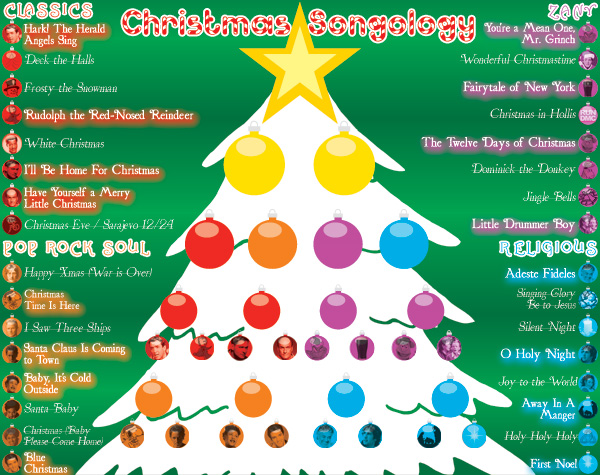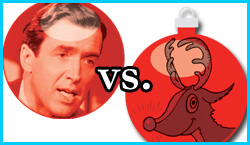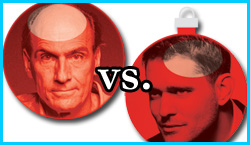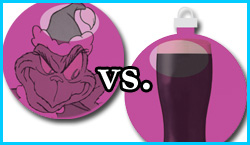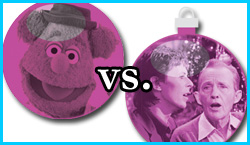Welcome to Round 2 of Christmas Songology, where you get to listen to, vote on, and ultimately declare which of these songs is the very best Christmas tune out there. Depending on your tastes, yesterday saw some of the very worst (or best) Christmas songs get knocked out of the running as both the Trans-Siberian Orchestra and Mannheim Steamroller were eliminated by the No.1 and 2 seeds in the Classics region.
However, in our humble opinion, three really, really good Christmas songs (and all No.2 seeds) got the boot in Round 1 (Jingle Bells, Christmas (Baby Please Come Home), Holy, Holy, Holy), not to mention Mariah Carey’s Joy to the World (No.3) and Sting’s I Saw Three Ships (No.4) which all just prove nothing more than we aren’t that good at seeding these things for our audience. But seriously, did anyone take the time to listen to Esquivel!’s Jingle Bells? It’s by far more superior, not to mention a lot more fun, than that Crosby/Bowie garbage and deserved better than it got. (By the way, unless you’re voting ironically, we hope you actually listened to Little Drummer Boy and found something you liked about it and aren’t just giving it a pass since it has Christmas golden boy, Bing Crosby, attached to it.)
Other observations: the voters much prefer Rudolph to Frosty, Gospel music did not go over well, and in a snub to Beatles’ fans everywhere, both John Lennon (No. 1 seed) and Paul McCartney (No. 8 seed) were eliminated from their respective regions.
Today there are some pretty good match-ups. Our advice: Listen to these songs (at least in the background) as if you’ve never heard them before, and then make your selections, and help these Christmas song ornaments make their way up the tree.
(Note: Many of these songs require you to sign up for a free Spotify account in order to listen to them.)
Rudolph the Red-Nosed Reindeer by Gene Autry
Hark! The Herald Angels Sing was written in 1739 by Charles Wesley, and was originally performed with a slow and somber tone, unlike the joyful and upbeat way it is often heard today, like in this iconic last scene from the 1946 classic It’s A Wonderful Life.
The first #1 song of the 1950s, Gene Autry’s recording of Rudolph the Red-Nosed Reindeer is the most popular rendition of the song as well as the second best selling Christmas song of all time, falling in just behind Bing Crosby’s White Christmas.
Have Yourself A Merry Little Christmas was performed by Judy Garland in the 1944 musical Meet Me in St. Louis. Though the song often follows the altered lyrics from Frank Sinatra’s cover (“Hang a shining star upon the highest bough”), James Taylor’s version restored the original line (“Until then we’ll have to muddle through somehow”), giving the song a more melancholy tone.
Michael Buble’s version of I’ll Be Home for Christmas is a cover of Bing Crosby’s 1943 hit.
Adeste Fideles is better known by its English translation, O Come All Ye Faithful. In the Christmas season of 1994, Andrea Bocelli sang “Adeste Fideles” for Pope John Paul II in St. Peter’s Basilica.
O Holy Night, a well-known traditional carol of the season, was composed in 1847 and happens to be the second piece of music ever broadcast on the radio in 1906.
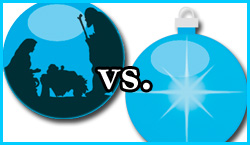
Away In a Manger performed by the Mormon Tabernacle Choir
Away in a Manger, a traditional Christmas carol from the 19th century, contains a verse that some nitpickers out there consider to be theologically ambiguous. It’s argued that “no crying he makes” implies that by not crying, Jesus could not have been fully human as is taught by orthodox Christian doctrine.
The First Noel is a traditional English carol from the 18th century. The word Noel comes from the French word Noël meaning Christmas, which derives from the Latin word natalis that translates as “birthday.”
Since 1965 Christmas Time is Here has been a perennial hit just like the television special it was written for, A Charlie Brown Christmas.
Santa Claus is Coming to Town dates back to 1934, but this popular Bruce Springsteen recording comes from a Long Island concert in 1975, (however, it wasn’t released until ten years later).

Baby, It’s Cold Outside by Ella Fitzgerald
Baby It’s Cold Outside was originally written and performed by Frank Loesser (of Guys and Dolls fame,) and his wife at their 1944 Christmas party. The song has since been covered by many artists through the years, though perhaps the most popular recording is that of Ella Fitzgerald and Louis Jordan (one of 8 recordings in 1949 alone!)
First recorded in 1948 by Doye O’Dell, Blue Christmas attained its greatest popularity in 1957 when it was covered by the King of Rock n’ Roll, Elvis Presley. The song is getting some special attention this year due to a new cover by 16-year old David Thibault on CKOI Quebec.
Fairy Tale of New York by The Pogues
With lyrics written by Dr. Seuss, You’re A Mean One, Mr. Grinch debuted as part of the 1966 animated special How the Grinch Stole Christmas!
Released in 1987 by the Celtic punk group The Pogues, Fairytale of New York was named after a novel by J.P. Donleavy. It has been called the greatest Christmas song of all time in various TV, radio and magazine polls and ranked #1 in VH1’s greatest Christmas song chart three years running.
The Twelve Days of Christmas by John Denver & The Muppets
John Denver collaborated with The Muppets for a full album featuring songs from their 1979 Christmas special, John Denver and the Muppets: A Christmas Together.
Bing Crosby and David Bowie’s Peace on Earth/Little Drummer Boy was filmed in 1977 for Bing Crosby’s Merrie Olde Christmas special. The pair never recorded the song in a recording studio, and Bowie’s half of the lyrics (the “Peace on Earth” section of the song) was written as a separate song because the pop star didn’t want to sing Little Drummer Boy.
